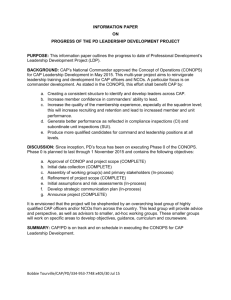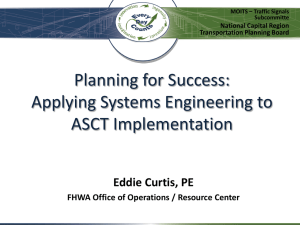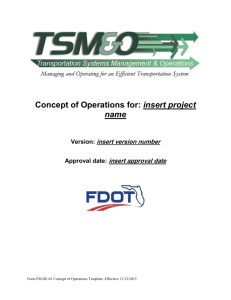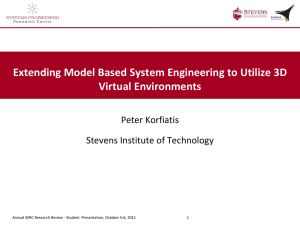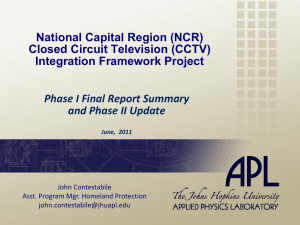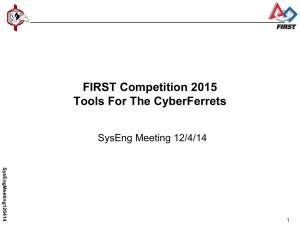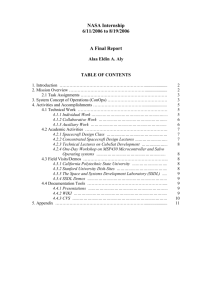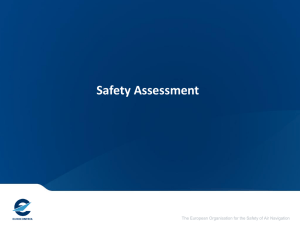Illustrating the Concept of Operations (CONOPs)
advertisement
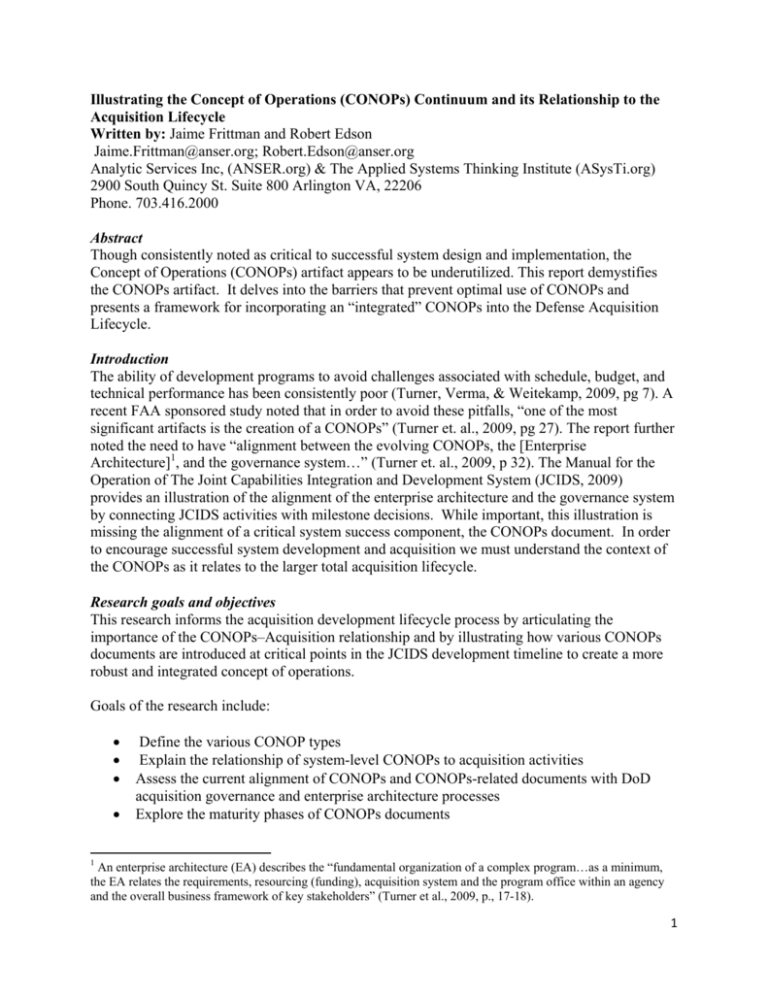
Illustrating the Concept of Operations (CONOPs) Continuum and its Relationship to the Acquisition Lifecycle Written by: Jaime Frittman and Robert Edson Jaime.Frittman@anser.org; Robert.Edson@anser.org Analytic Services Inc, (ANSER.org) & The Applied Systems Thinking Institute (ASysTi.org) 2900 South Quincy St. Suite 800 Arlington VA, 22206 Phone. 703.416.2000 Abstract Though consistently noted as critical to successful system design and implementation, the Concept of Operations (CONOPs) artifact appears to be underutilized. This report demystifies the CONOPs artifact. It delves into the barriers that prevent optimal use of CONOPs and presents a framework for incorporating an “integrated” CONOPs into the Defense Acquisition Lifecycle. Introduction The ability of development programs to avoid challenges associated with schedule, budget, and technical performance has been consistently poor (Turner, Verma, & Weitekamp, 2009, pg 7). A recent FAA sponsored study noted that in order to avoid these pitfalls, “one of the most significant artifacts is the creation of a CONOPs” (Turner et. al., 2009, pg 27). The report further noted the need to have “alignment between the evolving CONOPs, the [Enterprise Architecture]1, and the governance system…” (Turner et. al., 2009, p 32). The Manual for the Operation of The Joint Capabilities Integration and Development System (JCIDS, 2009) provides an illustration of the alignment of the enterprise architecture and the governance system by connecting JCIDS activities with milestone decisions. While important, this illustration is missing the alignment of a critical system success component, the CONOPs document. In order to encourage successful system development and acquisition we must understand the context of the CONOPs as it relates to the larger total acquisition lifecycle. Research goals and objectives This research informs the acquisition development lifecycle process by articulating the importance of the CONOPs–Acquisition relationship and by illustrating how various CONOPs documents are introduced at critical points in the JCIDS development timeline to create a more robust and integrated concept of operations. Goals of the research include: Define the various CONOP types Explain the relationship of system-level CONOPs to acquisition activities Assess the current alignment of CONOPs and CONOPs-related documents with DoD acquisition governance and enterprise architecture processes Explore the maturity phases of CONOPs documents 1 An enterprise architecture (EA) describes the “fundamental organization of a complex program…as a minimum, the EA relates the requirements, resourcing (funding), acquisition system and the program office within an agency and the overall business framework of key stakeholders” (Turner et al., 2009, p., 17-18). 1 Document the relationship of each instantiation of the CONOPs to acquisition related activities Assess the use of CONOPs and the disconnect, if any, between the perceived importance of CONOPs and the actual utilization of CONOPs. Methodology This research was conducted by combining traditional research methods with systems thinking tools and practices. Traditional analysis included literature review, data analysis, and comparative analysis. The Conceptagon2 framework for systems thinking was applied to the research data. This framework encourages holistic system analysis by providing a series of seven “triplets” related to specific system characteristics. Use of the Conceptagon provided insight into interior and exterior boundaries, information flows, hierarchies, and other relevant system characteristics. Though the individual sets of triplets are not explicitly discussed in this paper, each of the seven triplets served as a cornerstone for consideration of system characteristics throughout this research. Literature Review. A literature review of documents related to the role of CONOPs was conducted. This review included documents published in industry, in professional journals, acquisition journals, and in Department of Defense (DoD) regulations, instructions, and publications. The literature review also included the Defense Acquisition University Website which provided access to publications, communities of interest, and ask a professor question and answer forums. In addition to existing literature, a questionnaire related to the use and usefulness of CONOPs was developed and distributed (see Appendix A). The pool of survey respondents was too small to enable the extraction of valid conclusions. To overcome the lack of respondents, results of the survey were compared to a similar survey3 on the same subject. Data Analysis. Information collected during the literature review was assessed for: Term used Purpose Relationship to acquisition activities Relationship to integrated CONOPs This assessment was instrumental in establishing a baseline for the CONOPS artifact and its use within the development and larger acquisition process. 2 The Conceptagon is a systems thinking framework introduced by Boardman and Sauser (2008). For additional information on the Conceptagon as a systems thinking tool, reference Systems Thinking. A Primer (Edson, 2008) available at www.asysti.org. 3 The Roberts survey, conducted in 2008, inquired about the use, usefulness and upkeep of CONOPs. Roberts’ survey had a larger pool of respondents numbering 108 responses from 18 different companies. This pool significantly outnumbered the 6 responses gained from our own survey. Unlike the Roberts survey which was sent to engineers, and was composed of system engineers, lead system engineers, test engineers, design engineers, and project managers (Roberts, 2008), our pool of respondents included members of the user community, which offered an additional perspective to data gained from the Roberts survey. 2 Term Used & Purpose of the Document. For the first assessment a broad search of terms used synonymously with CONOPs was conducted. The initial assessment covered an array of CONOPs documents, looking at CONOPs that describe the actions of a military force or organization as well as CONOPs that detail characteristics of a system from an operator’s point of view. The intent of this assessment was to determine consistency of the meaning and purpose of the term CONOPs and to identify terms used in place of “CONOPs.” Once a set of recurring terminology was identified, the intended purpose of each document was recorded. This allowed us to assess similarities and variances associated with each of the terms. This assessment also gave us insight into role of CONOPs, if any, in acquisition activities as well as any barriers to the use of CONOPs. Relationship to Acquisition Activities. Variances among purpose and meaning were detected in the initial assessment. To account for the variance, each CONOPs-related document was plotted on a JCIDS-Acquisition relationship diagram. This enabled us to visualize different points of input and influence of each of the identified CONOPs-related documents. Using this assessment we further identified three distinct phases of CONOPs development that directly correspond to acquisition related activities. Relationship to Integrated CONOPs. Appearance of CONOPs- related documents in the JCIDS-Acquisition timeline revealed that CONOPs, either in an integrated form or in several smaller instantiations, occurred across the entire acquisition lifecycle. These documents (some termed “CONOPs,” others operating under a different name) were then assessed for their similarity to an integrated ConOps document spanning the full acquisition lifecycle.4 Systems Thinking. Analyzing system characteristics by use of the Conceptagon provided a comprehensive view of the acquisition lifecycle. Each set of triplets was considered as we looked at each aspect of the project. To illustrate, as we looked at the landscape of the system (i.e. governance, enterprise architecture, and CONOPs) we considered the triplet of wholes, parts, relationships. The larger acquisition system which included all three primary elements of the landscape was the whole, individual processes and inputs to the processes were considered parts, and the purpose of each input, and its effect on the whole constituted the relationships. The Value of CONOPs to System Development The value of a CONOPs to system development CONOPs Value is multi-faceted wherein the CONOPs plays a Helps scope the problem & solution role across the entire life-cycle: from need Bridges where we are and want to be identification, to system inception and development, to system disposition and disposal. Illustrates how a system will function Facilitates communications among stakeholders Our research of literature, standards, and instructions indicates a number of ways in which Provides a logic trail of capability Provides baseline for measuring system efficacy the CONOPs adds value to acquisition and Provides basis for requirements system development processes. Some of the key Table 1. Value of the CONOPs ways in which a CONOPs adds value are provided in Table 1. 4 For the purpose of this paper, the IEEE format for ConOps (IEEE,1998) is representative of an integrated CONOPs. The IEEE nomenclature for a concept of operations is ConOps as opposed to CONOPs. 3 Under-Utilization of the CONOPs Despite its value, the CONOPs, at least in its full form, is not consistently used in system development. In fact, a recent survey showed that 1/3 of all programs queried did not have a CONOPs (Roberts, 2008, p., 39). Similarly, in a series of interviews and surveys conducted for this research, the majority of respondents indicated that a CONOPs was “critical” to the system’s success, but was under-utilized. Comparable studies on CONOPs have pointed out that even when a CONOPs is written it is often after the system is developed and done so in an effort to satisfy a Milestone Decision requirement; this “box-checking” activity strips the CONOPs of its intended role in the creative process (Nelson, 2007, p. 5-6). Our survey results appear to support this, with our respondents indicating that a concept for how the system will be employed is usually written, but it is written after the system is developed. This means the CONOPs is based on the requirements as opposed to the requirements being based on the CONOPs. Similarly, in the Roberts survey, 18% of respondents said that CONOPs on programs they worked “were not completed until after the requirements were complete” (Roberts, 2008, p.28). With the CONOPs document seen as critical to defining and employing a proposed system, why is it that the CONOPs is often missing or developed as an afterthought? Barriers to Effective CONOPs Use Our research indicates that there are four barriers to the use of CONOPs throughout the acquisition lifecycle. These barriers include: 1. Definition and Purpose. There is variance in the term used to describe a CONOPs document, as well as an inconsistent application of the term. Often, this results in misunderstanding of what a CONOPs is, how it is used, and what type of information it should contain. 2. Targeted Audience. Closely tied to the variance in definition and use, the intended audience of the CONOPs document is unclear. 3. Timing and Placement in the Acquisition Development Lifecycle. There is confusion regarding to what phase of development a CONOPs applies. 4. Comprehensive View and Consistent Involvement by Stakeholders. Many forms of the CONOPs document are just a small subset of what system development really needs – these subsets do not incorporate a complete view of the system. Additionally, many of these CONOPs are by various authors using different stakeholder sets. Definition and Purpose. Our study detected considerable variance in the application of the term “CONOPs.” As a result of the variance, misunderstanding and purpose are major barriers to the use of CONOPs. This variance makes it unclear what a CONOPs is, how it should be used, by whom it should be used, and when it should be used. Military Concepts and System-Level CONOPs. Within the Department of Defense (DoD) there are higher order and lower order CONOPs. Higher-order CONOPs, include, Capstone, Institutional, Operating, Functional, and Integrating concepts, which, in descending order; become more narrow in scope and more detailed by applying to a smaller mission set (for clarity we will term higher-order CONOPs “military concepts” for the remainder of this document). These concepts “describe the conduct of military action at the operational level of war” (Schmitt, 2006, p.,1). Military concepts are derived directly from military strategy and provide a premise 4 for the future capabilities the military will need. According to Joint Publication 1-02, these CONOPs are a “verbal or graphic statement that clearly and concisely expresses what the joint force commander intends to accomplish and how it will be done using available resources” (JP102, p, 114). The materiel capabilities needed to achieve the goals of the military concepts are described in lower order, system-level CONOPs. The system-level CONOPs band includes capability specific CONOPs. According to the Institute for Electrical and Electronics Engineers (IEEE) these CONOPs are a “user-oriented document that describes system characteristics for a proposed system from the user’s viewpoint” (IEEE, 1998, p., i). Additional CONOPS Variance. Within both military concepts and system-level CONOPs there are several types of documents – all of which are called either “CONOPs” or some variation of the term “CONOPs.” Joint Service and Component Service publications5, have already defined and documented the different types of military concepts (i.e. institutional, operating, etc). However, the different types of system-level CONOPs are less well defined and vary from publication to publication. Adding to the confusion is the fact that each CONOPs document may include similar or dissimilar information.6 The Perceived Purpose of the CONOPs Document. As discussed above, the purpose of a CONOPs can range from describing aspects of a military operation (military concept) to describing characteristics of a specific system (system-level CONOPs). But even within systemlevel CONOPs, the purpose can range from describing all system attributes, system stakeholders, and system tasks, to focusing solely on the employment of the system. Examples of different CONOPs document names and associated purposes are provided in Table 2. Table 2. Perceived Purposes of CONOPs Term User CONOPs System CONOPs ConOps Purpose [Defines] basic system requirements. [It] describes what the user wants the system to achieve and the context in which the system will be utilized [Defines] how the system will actually be used and provides insight into the total system solution for both short-term and long-term requirements. Similar to ANSI/AIAA7 OCD Provides the user community a vehicle for Reference Companion & Mortimer, n.d Companion & Mortimer, n.d. Jost, 2007, p. 14 5 Types of military concepts are defined in publications such as the Chairman of the Joint Chiefs of Staff Instruction 3010.02 “Joint Operations Concept Development System”; the Air Force Policy Directive 10-28 “Air Force Concept Development”; CONOPs TO DOCTRINE: Shaping the Force From Idea Through Implementation (Fleet Forces, 2004). 6 Daniels & Bahill (2004) point out that “CONOPs documents are rarely consistent in content, detail, and format” (para 4, p. 307). 7 ANSI/AIAA is an abbreviation for the American National Standards Institute/American Institute of Aeronautics and Astronautics. ANSI/AIAA standard G-043-1992, Guide for the Preparation of Operational Concept Documents, discusses information that relates to system operational concepts and describes “which types of information are most relevant, their purpose, and who should participate in the effort” (ANSI/AIAA, 1993, abstract). 5 describing their operational needs that must be satisfied by the system under development Provides “a capability description (what an CONOPs operational unit does) or a prescription of what should be done.” “[Transforms] the allocated what to the how ConOps and so completes a chain all the way to an instantiation…of the system that enables capabilities.” Description of “how a weapon system will be Concept of Employment [used] in a combat environment” [Provides] the vision and intent for how the CONOPs system should work within an operational environment in an easy to read format. Similar to a CONOPs (see preceding CONOPs Use-Case definition) but less ambiguous and therefore can Scenarios be used directly for extracting requirements in an unambiguous way. Nelson, 2007, p. 2 Nelson, 2007, p. 2 Ask a Professor (AAP, 2009 Daniels & Bahill, 2004, p. 306, sec 4.1 Daniels & Bahill, 2004, p. 307,sec 4.1 Targeted Audience. Just as the name for and content of a CONOPs document varies, so may the intended audience. Currently the audience is dependent on who is writing the CONOPs, what type of CONOPs is being written, and its intended placement within the acquisition timeline. The CONOPs can be written to speak to all communities or can focus on individual communities, such as engineers, customers, test agencies, or decision authorities. A CONOPs that only speaks to a specific community may be problematic in its potential to lack sufficient detail required by the unaddressed audience. Timing and Placement in the Acquisition Lifecycle. The placement of the CONOPs refers to the insertion point of the CONOPs into the larger acquisition activity. The “input” of the CONOPs into the acquisition process is dependent upon the identified purpose of the CONOPs document. For instance, a military concept will occur earlier in the acquisition lifecycle than a system-level CONOPs. With the relative importance of the CONOPs widely understood (see Table 1), it is difficult to envision proceeding through the acquisition lifecycle without some form of the CONOPs document. To that end, we believe that although not necessarily called a CONOPs, and not in a neat and integrated package, critical elements of the CONOPs are occurring in an ad-hoc manner across the acquisition timeline. Nelson echoes this stating that, “[the] main reason we overlook the central role and scaling of the ConOps is that we give different names to the same thing at different scales” (Nelson, 2007, p., 9). CONOPs Placement According to Official Literature. In DoD acquisition documents, such as the DoD 5000 series and JCIDS documents, CONOPs are identified as an input to a larger acquisition process. In these documents the term “CONOPs” on its own usually refers to a military concept. As such, it is placed as a precursor to system concept selection. Figure 1 provides an organizational construct for the position of the military concept to the JCIDS 6 timeline. This construct depicts the hierarchy of military concepts as a linear progression from broad to most narrow focus (left to right) These military concepts then feed into the JCIDSAcquisition process as a basis for the Capabilities Based Assessment (CBA). Figure 1. Relationship of the Military Concept to JCIDS-Acquisition (Modified from JCIDS, 2009) The Manual for the Operation of JCIDS references at least two more “types” of CONOPs. The first of these is found in Enclosure B of the JCIDS Manual. Here, the reference is to a “sustainment CONOPs” (JCIDS, 2009, p. B-B-5). The manual states that as a sustainment key performance parameter (KPP) metric, the sustainment CONOPs should be traceable to the system’s Initial Capability Document (ICD) and Capability Development Document (CDD). This implies that the sustainment CONOPs is an input to the acquisition lifecycle process after the ICD and CDD have been written8. A second reference to CONOPs is made later in Enclosure B. This time, the reference is to a “CONOPs… for the system”. Contextually, this CONOPs for the system, or System CONOPs, provides documentation of “...a comprehensive analysis of the system and its planned use, including the planned operating environment, operating tempo, reliability alternatives, maintenance approaches, and supply chain solutions…” (JCIDS, 2009, p. B-B-6). Based on this description the JCIDS System CONOPs is similar to the latter half of the IEEE ConOps. This System CONOPs is an input to the JCIDS process post Milestone B, upon program initiation. JCIDS also acknowledges the analysis of alternatives (AoA) that is part of the larger acquisition process. The AoA is a precursor to the Milestone A decision. The analysis of alternatives, though likely more detailed than what is included in the CONOPs, corresponds to the IEEE ConOps Alternatives section which discusses system alternatives considered, but not selected. Figure 2, provides a rough illustration of the relationship of these documents (to include the concept of 8 Though not explicitly defined in the manual, contextually the sustainment CONOPs is a concept of operations specific to maintenance approaches and supply chain solutions. This definition makes the implied position of the sustainment CONOPs somewhat confusing, because maintenance and sustainment concepts communicate desired sustainment instructions that inform system design and planning. The sustainment CONOPs will likely be more detailed post milestone B and C, but per the IEEE format, should be written, if even in an immature state, with the original system-level CONOPs. 7 employment (COE) which is recognized by DAU as an input to capability development documents) to JCIDS-Acquisition decisions. Figure 2. Relationship of Official CONOPs-Related Documents to JCIDS-Acquisition Activities In addition to documents described in the JCIDS manual, our research revealed that there are many other documents in use that serve as inputs to the acquisition process. Such inputs include ConOps (described by Nelson), use-cases (as described by Daniels & Bahill, 2004), user CONOPs, and system concepts (see Table 2). The relationship of these inputs to the JCIDSAcquisition timeline is illustrated in Figure 3. Figure 3. Relationship of Unofficial CONOP-Related Documents to JCIDS-Acquisition Activities This mapping of CONOPs documents to the acquisition lifecycle suggests that CONOPs documents are developed throughout the acquisition lifecycle. Comprehensive View and Consistent Involvement by Stakeholders. As illustrated above, many separate CONOPs documents are written. A risk to proper use of these CONOPs is that these various CONOPs are independently authored by various individuals or groups that may have different perspectives on the system and system objectives. Without a single, integrated, system-level CONOPs to draw from, requirements may be unintentionally derived from multiple sources that may or may not include a complete understanding of system uses. This can create “[different] and potentially conflicting views of system use [that] will result in a system that only partially meets the user’s expectations” (IEEE, 2008, para, 3.3.3, p., 23). Additionally, breaking the CONOPs into smaller non-integrated documents runs the risk of reducing stakeholder coordination. This practice also reduces the comprehensiveness of the 8 stakeholder input, which in-turn degrades the completeness of perspectives and resulting system requirements. Key to Effective Use of CONOPS in the Acquisition Life Cycle: The Integrated CONOPs Despite the occurrence of the various types of CONOPs documents, Nelson (2007) argues that although many documents go by the name CONOPs, there is only one “true” ConOps9 and it is the ConOps described in the IEEE10 standard 1362-1998. Nelson goes on to state that the power of the IEEE ConOps comes from its comprehensive assessment of both the “what” (system identification) and the “how” (system employment). In our assessment, the IEEE format also includes the “why” in its section titled Justification. Traceability to the why, or justification, is an important factor in maintaining system validity and verification. 11 Unique to the IEEE format is its emphasis on describing not only the desired capability and end-state, but also the current capability and situation. This end-to-end emphasis provides a logic trail from original need to capabilities pursued. Integration of Individual Inputs Because the many types of CONOPs-related documents appear to span the entire lifecycle of the system, we wondered how these individual CONOPs would relate to the IEEE ConOps. To find out, we delineated the relationship of the individual CONOPs documents to sections of the IEEE ConOps (Figure 4). To conduct this assessment, the content of each of the CONOPs documents used as an input to the acquisition process was analyzed. This content was then compared to the content in each section of the IEEE ConOps to identify similarities. Arrows are provided from CONOPs documents to applicable IEEE ConOps sections to show a relationship between the content. Figure 4. Relationship of CONOPs Documents to IEEE ConOps 9 Nelson uses the IEEE abbreviation for ConOps to distinguish it from other forms of concept of operations documents, which are often abbreviated as “CONOPs” (Nelson, 2007). 10 IEEE, pronounced (I-triple –E) IEEE is recognized as a leading institution in systems and system standards. Their format for ConOps documents (IEEE, 1362-1998) is comprehensive and is used by many agencies/ organizations. 11 In their paper on famous failures, Bahill & Henderson note that “[system] validation requires consideration of the environment that the system will operate in” (2005, p., 3). 9 An Example of a CONOPs Document–IEEE ConOps Relationship. The guiding military concept provides insight into the operational environment, the scope of the mission set, and the need for the system. Although this concept does not provide an exhaustive list of system user classes, it will provide insight into an initial group of potential system stakeholders. Therefore a relationship is shown between the military concept and the IEEE sections of: Current Situation, Background and Scope, Policies and Constraints related to the current situation, User Classes, and Justification for Change. Identification of these relationships confirmed that, while not necessarily an integrated ConOps such as IEEE, elements of the IEEE ConOps are being utilized in the acquisition process via the many, currently occurring CONOPs documents. All IEEE ConOps sections are addressed in the currently occurring CONOPs-related documents with the exception of a detailed explanation of the modes of operation for the current system (this would include modes for legacy systems currently in place) and administrative sections such as referenced documents and document overview. This means there may be an opportunity to integrate elements of each of these documents into an integrated CONOPs, such as the IEEE ConOps12. The Value of an Integrated CONOPs Over the Current Way of Business Although already occurring independently across the lifecycle, integrating individual CONOPs documents into a single CONOPs document has potential to increase both traceability and continuity. Traceability. According to IEEE, traceability is “a key tool for ensuring that the system developed fully meets the needs and requirements defined by the user” (IEEE, 2008, para, 4.2, p., 38). An integrated system-level CONOPs resolves, or at least mitigates the problem of conflicting system views and partially met requirements by using the same resources to create a more complete view of the problem, the proposed solution, the user community, and the intended uses. This pooling of information allows stakeholders an opportunity to recognize requirement needs and contradictions that are otherwise overlooked.13 Continuity. Both IEEE and ANSI identify a purpose of the CONOPs as a means by which to communicate system characteristics in such a way that is understandable by all system stakeholders. 14 Continuity is an enabler of the required communication and stakeholder involvement. Similar to what is seen with traceability, continuity suffers when the integrated system-level CONOPs is broken out into multiple documents. 12 Integrating each of these inputs into a comprehensive CONOPs document does not preclude the use of or independent improvement of particular sections. Products, such as an AoA, can continue to stand-alone; in fact AoAs can inform later iterations of the CONOPs document. The point of the integrated CONOPs is not to enforce a rule set – but rather to serve as a means for conducting holistic problem and solution space exploration and for providing a document owned by all stakeholders that clearly and logically expresses the system’s characteristics. In this way, the CONOPs serves as the baseline document to which all subsequent documents are loyal. . 13 According to the INCOSE SE Handbook, version 2a (2004) one use of a CONOPs is “[t]o validate requirements at all levels and to discover implicit requirements overlooked in the source documents” (para 8.2 f, p., 104). 14 “The CONOPs document is used to communicate overall quantitative and qualitative system characteristics to the user, buyer, developer, and other organizational elements” (IEEE, 1362-1998, p., 1). The CONOPs document “facilitate[s] understanding of the overall system goals with users…, buyers, implementers, architects, testers, and managers” (ANSI/AIAA, 1993, p., 1.) 10 The Relationship of the Integrated CONOPs to the Acquisition Lifecycle Current literature provides an illustration of the relationship of military concepts to JCIDSAcquisition activities (Figure 5). This is in line with our assessment of the relationship of military concepts to acquisition activities (see Figure 1). What appears to be missing though is an illustration of the relationship of the system-level CONOPs to the acquisition lifecycle. If we integrate the many CONOPs documents into a single integrated CONOPs document, what will its relationship to the acquisition lifecycle Figure 5. Requirements and Acquisition Process Flow look like? (Modified from, DoDI 5000.02, 2008) The streamlined CONOPs-Acquisition lifecycle relationship, or CONOPS continuum, is most easily depicted by building upon a baseline graphic (Figure 6) and gradually adding in additional relationships. Initially this illustration depicts two major inputs to the JCIDS-Acquisition process. The first of these is the higher order military concept which is a basis for a CBA and identifies the context in which the proposed system will operate. System-level CONOPs emerge when the CBA process identifies capability gaps for which a materiel solution is the preferred solution. This results in a relationship between higher-order military concepts and acquisition and between higher-order military concepts and system-level CONOPs (which we will term simply “CONOPs”). As illustrated in Figure 6, military concepts drive CBAs and Doctrine, Organization, Training, Materiel, Leadership, Personnel, Facilities (DOTMLPF) changes and are the context for CONOPs, which must always support the activities outlined in the military concepts. Figure 6. Concept-CONOPs-JCIDS-Acquisition Relationships (CONOPs Continuum) Higher-order military concepts are the basis from which CBAs and systems in development are derived. As such it is imperative that the vision, mission, and goals of military concepts are valid. Invalid or inaccurately assessed military concepts can result in faulty CONOPs and ineffective systems. Therefore, the exercise and evaluation process that validates the military concept is an equally essential part of successful CONOPs development and, ultimately, of successful system development. Figure 7 depicts the relationship of experimentation to military concepts, with military concepts driving experimentation, which informs or validates the military concept. 11 Military concepts that are invalidated should be changed and retested. Once validated, the military concepts then drive CBAs or DOTMLPF changes. Figure 7. Experimentation as Part of the CONOPs Continuum Because CONOPs are the basis for system requirements, they also interact with the JCIDSAcquisition processes. Initially, the CONOPs informs the ICD. As the system progresses through the acquisition lifecycle, events in system develop should inform the CONOPs. This process of revisiting and updating the CONOPS will help ensure it remains relevant. This ongoing cycle of informing and updating is illustrated in Figure 8. 15 The importance of the figure resides in its simplistic illustration of the interconnectedness of many activities. The picture now shows a series of ongoing interconnected processes each reliant on and influencing the other, versus strict swim lanes of disparate processes. Figure 8. Interconnectedness of CONOPs and Acquisition Activities CONOPs Maturation and Phases Ideally, the CONOPs should be updated throughout the acquisition lifecycle, such that as the system matures the CONOPs increases in specificity. We have identified specific phases of CONOPs maturity each of which coincides with events in the acquisition lifecycle. 15 The figure also shows the independent role of the AoA. The AoA informs both the higher and system-level concepts. The AoA has potential to influence DOTMLPF solutions that impacts the way a Service fights, trains, and equips. The AoA informs the system-level CONOPs section on alternatives considered. 12 CONOPs (Initial Phase). Initially, the CONOPs describes the proposed system as a ‘black box’ and in its most ideal form (i.e. all user desired capabilities). This initial phase of the CONOPs will be used to guide the development of the ICD and serves as a basis for system requirements. CONOPs (Discovery Phase). The suggested update cycle is triggered by specific events in the acquisition lifecycle. Initially, the CONOPs informs the Technology Development16 (TD) phase by communicating desired capabilities, for which technology must be developed. Likewise, the TD process informs the CONOPs, by revealing actual technological possibilities. As TD progresses and technological possibilities become more evident, the CONOPs document should be updated to reflect actual capability. This activity will ensure that the user gets the system expected and that the system, though not as initially envisioned, still meets the operational need(s) described in the military concepts. The updated CONOPs and the ICD are the foundation for the CDD requirements generation process. Following the CDD and Milestone B, the system enters the Engineering, Manufacturing, and Development (EMD) phase17. Results from the EMD activities bring additional clarity to the system’s operational limitations and advances. Therefore, EMD results should further inform the CONOPs such that it can again be updated to reflect actual system capability. Again, the updated CONOPs will be used as the basis for the requirements captured in the Capability Production Document (CPD). As with previous updates, the updating process will continue to maintain traceability between the user’s expectations and the operational mission the system supports. CONOPs (Employment Phase). Shortly after Milestone C system prototypes enter into low rate initial production (LRIP). LRIP models will generate user feedback, which will further inform the CONOPs. LRIP feedback provides the information needed to fully understand how the final system can and will be used. This feedback should be incorporated into a final version of the CONOPs. Throughout the updating cycle, the CONOPs must be compared to the higher order military concept(s) it supports to determine that it still supports the goals, missions and activities of the military concepts. The continuous review of the military concepts and CONOPs relationship is particularly important in long-lead time acquisition programs; over time introduction of new systems, new threats, and new political environments can change the battle field to the point that the system no longer serves a valid mission set18. The CONOPs maturity phases align with major phases of the acquisition cycle (i.e. MDD, TD, EMD, and deployment and employment). This results in three distinct phases of the CONOPs document. We have termed these phases: Initial, Discovery, and Employment, the names of which correspond to the level of system understanding discussed above. A graphical 16 During the technology development phase, “technologies are developed, matured, and tested” (Schwartz, 2009, p.9) 17 During the EMD phase “various subsystems are integrated into one system and a development model or prototype is produced” (Schwartz, 2009, p. 10). 18 Although we have identified specific drivers of a CONOPs review, the idea of updating CONOPs is not new. Most guiding documents agree that the CONOPs is a “living document” (ANSI/AIAA, 1993; IEEE 1362-1998; Daniels & Bahill, 2004). Even still, in a survey of systems engineers and lead systems integrators, respondents indicated that “[over] 50% of [CONOPs] were not updated throughout the entire program lifecycle and of those 49% were only updated through preliminary design review. (Roberts, 2008, p. 28). 13 representation of these phases as they relate to the JCIDS-Acquisition timeline is provided in Figure 9. Figure 9. CONOPs Phases as Related to JCIDS-Acquisition The integrated, maturing CONOPs provides a mechanism for tracing system elements such as requirements, perspectives, decisions, and solutions. Summary Undeniably, the system-level CONOPs has the ability to influence the success of activities across the entire acquisition lifecycle. To fully realize the benefit of these CONOPs we must first resolve outstanding issues related to barriers of the CONOPs use. First, we must work as a community to promulgate a single, agreed upon definition for the term CONOPs. Secondly, we must work to combine existing CONOPs documents into an integrated and comprehensive document that speaks to many audiences. The integrated CONOPs will reduce the risks of inconsistent and unmet requirements by ensuring effective collaboration by stakeholders throughout the development life cycle. Once the CONOPs is created, we must remember its alignment with military concepts and acquisition activities and the influence each of these has on the other. Finally, we must remember to revisit the CONOPs and allow it to mature over time. Although a potentially demanding and lengthy process, use of CONOPs will amplify the rapid and cost effective delivery of usable systems that meet warfighter needs. Author Biographies Jaime Frittman. Jaime is a Senior Analyst with Analytic Services Inc. Jaime began her career in the United States Air Force working in the field of Readiness and Emergency Management. Jaime applied her knowledge of Chemical, Biological, Radiological, Nuclear (CBRN) Warfare Defense and Response to the development and acquisition of CBRN Defense Weapon Systems. Jaime has a Master’s of Engineering in Systems Engineering from Steven’s Institute of Technology. Robert Edson. Robert Edson is Vice President for Enterprise Development at Analytic Services Inc., and Director of the Applied Systems Thinking Institute (ASysT). He is responsible for strategic and transformational programs within the corporation. In his role as Director of ASysT, he leads an institute whose mission is to advance the application of systems thinking principles in the fields of national security and homeland security. Robert is an Adjunct Professor at 14 Stevens Institute of Technology and has a BS in Biology from George Mason University and a MS in Physical Oceanography and Meteorology from the Naval Postgraduate School. 15 Reference List Air Force (2003, September)."Air Force Policy Directive 10-28." Air Force Concept Development. (ANSI/AIAA) American Institute of Aeronautics and Astronautics. (1993). Guide for the Preparation of Operational Concept Documents. American National Standard. Washington, DC: American Institute of Aeronautics and Astronautics. Ask a Professor (APP). (2009, May 20). Question & Answer Detail Program Management. Retrieved November 2009, from Defense Acquisition University: https://akss.dau.mil/askaprofakss/qdetail2.aspx?cgiSubjectAreaID=9&cgiQuestionID=28681 Bahill, T.H., Henderson, S.J. (2005). Requirements Development, Verification, and Validation Exhibited in Famous Failures. Systems Engineering, 8 (1), pp. 1-12. Retrieved, October 2009, from www.sie.arizona.edu/sysengr/publishedPapers/famousFailures.pdf Boardman, J., Sauser, B. (2008). Systems Thinking: Coping with 21st Century Problems. Boca Raton, CRC Press Taylor & Francis Group. Chairman of the Joint Chiefs of Staff Instruction. (2006, January 27). "Joint Operations Concepts Development Process (JOpsC-DP)." CJCSI 3010.02B. Companion, M., Mortimer, C. (n.d.). Designing for change: A modeling and simulation system approach. Arlington, Texas: Raytheon Systems. Available at, www.link.com/pdfs/itsec2.pdf Daniels, J. & Bahill, T. (2004, July 7). The Hybrid Process that Combines Traditional Requirements and Use Cases. Systems Engineering, 7 (4), pp. 303-319. Retrieved October 2009, from www.sie.arizona.edu/sysengr/publishedPapers/hybridProcess.pdf Department of Defense (DoD). (2008). Instruction 5000.02 “Operation of the Defense Acquisition System.” December 8, 2008. Edson, R. (2008). Systems Thinking. Applied. A Primer. Arlington, VA: Analytic Services, Inc. Fleet Forces Command. (2004)."CONOPs To Doctrine: Shaping the Force From Idea Through Implementation." (PDF Slides). SEA TRIAL Presentation to the Corps of Naval Attaches. PreDecisional-Draft Working Papers. Retrieved June 2009, from www.ndia.org/Divisions/Divisions/.../Content/.../CONOPS_101.pdf IEEE Standards Board. (1998). IEEE Standard 1362-1998, IEEE Guide for Information Technology-System Definition- Concept of Operations (ConOps) Document. Standard. New York. Institute of Electric and Electronics Engineers, Inc., 1998. IEEE Press/Standards Information Network. (2008, November 4). Guide for Implementing IEEE Std 1512TM Using a Systems Engineering Process. Prepared for Federal Highway Administration (FHWA) & Institute of Electrical and Electronics Engineers (IEEE); prepared by Klotz Associates, Inc. in association with Consensus Systems Technologies, SubCarrier Systems Corporation. ISBN 978-0-7381-5674-3. Available at, http://standards.ieee. org/standard press/. International Council on Systems Engineering (INCOSE). (2004). Systems Engineering Handbook: A "What To" Guide for All SE Practitioners. (INCOSE-TP-2003-016-02) Version 2a. Joint Capabilities and Development System (JCIDS). (2009). “Manual for the Operation of the Joint Capabilities Integration and Development System.” Joint Publication 1-02. “Department of Defense Dictionary of Military and Associated Terms." 12 April 2001as ammended through October 2008. 16 Jost, A. (2007, October). ConOps: The Cryptex to Operational System Mission Success. Cross Talk The Journal of Defense Software Engineering, 20 (10), 13-16. Available at, www.stsc.hill.af.mil/crosstalk/2007/10/0710Jost.html Nelson, G. (2007). The ConOps in a Self-Similar Scale Hierarchy for Systems Engineering (Paper # 69). Conference on Systems Engineering Research. Hoboken, NJ. Roberts, N. (2008). An Analysis of Concept of Operation Development (Master's Thesis, Steven's Institute of Technology, 2008). Schmitt, J. (2002, December) A Practical Guide for Developing and Writing Military Concepts. Defense Adaptive Red Team Working Paper. McClean VA: Hicks and Associates, Inc. Available at, www.au.af.mil/au/awc/awcgate/dod/dart_guide.pdf Schwartz, M. (2009, July 10). "Defense Acquisitions: How DoD Acquires Weapon Systems and Recent Efforts to Reform the Process." Congressional Research Service. Retrieved September 2009 from, at www.fas.org/sgp/crs/natsec/RL34026.pdf. Turner, R., Verma, D., & Weitekamp, M. (2009). “The Next Generation Air Transportation System (NextGen).” School of Systems and Enterprises. Stevens Institute of Technology. 17 Appendix A – Survey Questionnaire The following questionnaire is issued to gain insight into current acquisition processes and to understand perceived shortcomings (if any), and suitable fixes to the identified shortcomings. The ultimate goal of this research is to contribute to efforts to provide the warfighter with needed capabilities in a timely and cost efficient manner. Answers to this questionnaire are non-attributable meaning answers provided will not be credited to any particular respondent. Furthermore, prior to being included in any published document, any/all answers will be generalized such that specific programs, offices, and/or systems under development will not be identifiable. Your honest answers are greatly appreciated. Respondents who would like a copy of our research end product can request so by emailing me at jaime.frittman@anser.org. 1a. In how many programs of record do you currently participate, or have you previously participated (an estimate is “ok”)? ______________________________________________________________________________ ______________________________________________________________________________ 1b. What is or has been your role in these programs? ______________________________________________________________________________ ______________________________________________________________________________ 2. How do you define the term concept of operations (CONOPs)? ______________________________________________________________________________ ______________________________________________________________________________ 3. In your personal opinion, what is the role/purpose of a CONOPs? ______________________________________________________________________________ ______________________________________________________________________________ 4a. Have you ever written a CONOPs? ______________________________________________________________________________ ______________________________________________________________________________ 4b. If so, what type of content did you include in the CONOPs? ______________________________________________________________________________ ______________________________________________________________________________ 4c. Did you use a certain standard or prescribed template? If so, which one? ______________________________________________________________________________ ______________________________________________________________________________ 4d. Was the CONOPs updated throughout the development cycle? ______________________________________________________________________________ ______________________________________________________________________________ 18 4e. Do you believe the CONOPs was properly utilized, or underutilized? ______________________________________________________________________________ ______________________________________________________________________________ 5. How important do you think a CONOPs is to the successful development and employment of the system to which it applies? ______________________________________________________________________________ ______________________________________________________________________________ 6. Off the top of your head, can you think of any shortcomings related to CONOPs as they relate to current systems under development? Please describe these shortcomings. ______________________________________________________________________________ ______________________________________________________________________________ 19
